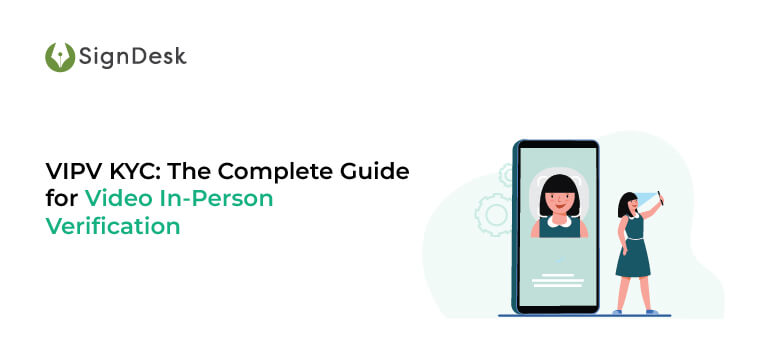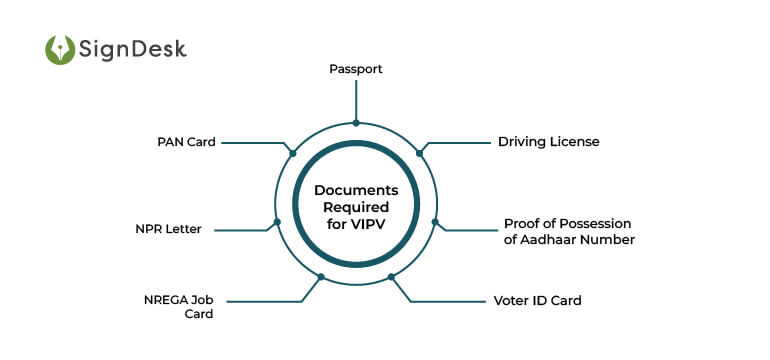Video-KYC: Game-Changer For Investor KYC Verification
Video-based KYC is a remote digital in-person verification process where the user can complete KYC verification in a fast and secure manner without visiting any brick-and-mortar location. Video KYC can be done in many ways serving the requirement of financial institutions adhering to the video KYC guidelines. VIPV or Video in person verification is a KYC process introduced by SEBI later in 2020 after RBI announced guidelines for video KYC (VCIP) on January 9, 2020, to provide proper financial services digitally.

KYC (Know Your Customer) guidelines in financial services were first introduced in 2002 by RBI. KYC and Customer Due Diligence (CDD) policies are an integral part of KYC and IPV verification and establish a secured foundation for an effective anti-money laundering process. For a seamless fraud-proof KYC process, every SEBI Registered Intermediary (RI) needs to collect and authenticate the Proof of Identity (PoI) and Proof of Address (PoA) from the investor.
With the help of the digital video in-person verification process, the RIs can onboard investors immediately and perform online KYC for mutual funds preventing fraudulent activities, money laundering fraud, identity theft, and document fabrication.
What is VIPV?
VIPV or Video in person verification is the video kyc verification procedure introduced by SEBI to identify and authenticate their investors remotely. VIPV process is for the SEBI registered intermediaries who want to start and continue account-based relationships with individual investors.
SEBI released a circular “Clarification on Know Your Client (KYC) and Use of Technology for KYC” notifying the changes to the existing digital KYC procedures on 24th April 2020. The circular mainly focused on technological innovations which can facilitate online KYC. With the new regulations for VIPV, the digital KYC procedure for SEBI has become faster and more efficient.
Typically, RIs perform the VIPV process with the submission of KYC documents to complete investor onboarding through a sufficiently audited application which preserves the activity log of the entire workflow for future reference mentioning the date and timestamps. VIPV consists of a face-to-face interaction with a trained official who makes sure that the customer’s face is easily recognizable through the video feed. The entire process must take place in a live environment and RIs must ensure that once the process is completed, the video & logs are stored in a safe, secure & tamper-proof manner.
SEBI Guidelines for VIPV
SEBI launched the April 24 circular to simplify the process of VIPV KYC verification with regulatory guidelines. Technological evolution has created innovative digital platforms that paved the way to implement various ways to digitize and automate paper-based workflows allowing to execute KYC process online.

- E-Sign Service – Electronic Signature service that can facilitate an Aadhaar holder to forward the document after digitally signing under the eSign Signature framework of the IT Act 2000, and guidelines issued by the controller.
- Equivalent e-document – Electronic equivalent of a document issued by the issuing authority, including documents issued to the Digital Locker account of the investor as per Rule 9 of the IT (Preservation and Retention of Information by Intermediaries Providing Digital Locker Facilities) Rules, 2016.
- App-based Online KYC – The Registered Intermediaries can complete the KYC verification through their own online portal or App using in-person verification through video.
- PAN – PAN is verified online using the Income Tax Database.
- Bank Account Details – Using the Penny Drop mechanism or any other mechanism using the API of the bank, KYC verification can be done in the VIPV process.
- Any Other OVD – Other than Aadhaar, the accepted OVD (Officially Valid Documents) are according to the PML Rules, 2005:
- The Passport
- Driving Licence
- Voter Card
- Job Card issued by NREGA
- NPR Letter
- PAN Card
There are certain exceptions to the in-person verification (IPV) process –
- IPV/VIPV will not be required when the KYC of the investor is completed using the Aadhaar-based authentication of UIDAI.
- IPV/VIPV will not be required by the RI when the KYC form has been submitted online, documents have been provided through DIgilocker or any other source which can be verified online.
How to Conduct VIPV?
The outline of the overall workflow of VIPV given by SEBI follows a few easy steps.
- The customer visits the website/App/Digital platform of the RI and fills up the online KYC form digitally inputting all necessary details and submits requisite documents online.
- An authorized official of the RI begins the VIPV process of the investor after confirming consent to initiate the video call with the customer.
- The customer uploads the OVDs (Official Verified Documents).
- The process takes place in a real-time life environment with a clear video call.
- The customer displays their ID proofs, KYC form, and signature. The name, photograph, address, mobile number, email ID, and Bank details of the investor should be captured online. For alternate authentication, OTP is used to verify these documents. Aadhaar is verified through UIDAI’s authentication mechanism.
- AI verifies the facial matching with the customer’s facial attributes to the picture in the ID proof.
- During the video call the liveness is detected through random questions and responses.
- After the interaction is concluded, the video is saved securely with the date and time stamps.
Simplified Workflow of VIPV
Online KYC Form is Filled
↓
VIPV is Commenced after Consent
↓
OVDs are Uploaded
↓
Live Interaction is Initiated
↓
Image Capture or OTP Validation
↓
Image Data Verification
↓
Facial Matching and Geo-tagging
↓
System Driven Randomized Questionnaire
↓
VIPV Completed
↓
Video is Saved and Stored with Customer Details
↓
Official approves/rejects KYC
Onboarding Challenges For SEBI Intermediaries
Even though introducing eKY made the KYC verification cost and time-effective process instantly popular among financial institutions, due to large-scale security concerns, the Supreme Court ruled out in 2018 that financial institutions can not use eKYC for KYC verification.
For ease of doing business SEBI launched the guidelines for a digital video-based KYC process during the pandemic lockdown to onboard investors seamlessly complying with the PMLA (Prevention of Money Laundering Act) and AML (Anti Money Laundering). There are a few onboarding challenges in physical workflow for SEBI intermediaries.
- Multiple Cycles
In conventional workflows there are multiple cycles and follow-ups that make the KYC process lengthy.
- Paper-based Workflow
Physical paper-based workflows are messy and require preservation and high-security measures that are very risky and prone to fabrication.
- High TAT
KYC forms and OVD documents are sent to the authorized offices for verification and remain in courier transit for long periods of time. This makes the whole process time-consuming causing low productivity and high turnaround times.
- Low Visibility
The traditional KYC process depends on customers and officials in the offline method without any tracking system and milestones. Hence, the workflows take so much time to execute one KYC verification slowing down the overall onboarding process.
VIPV Solution For Smooth Onboarding
Due to regulatory compliances the registered intermediaries did not have clear guidelines to follow the digital KYC process. The primary guidelines of online KYC for mutual fund were not under proper regulatory compliance. Therefore most intermediaries were struggling to stick to the physical workflow to perform KYC verification.
With the SEBI circular, investment advisory firms, PMS firms, KYC registration agencies (KRAs), Mutual Funds agents such as AMFI (Association of Mutual Funds in India), AIFs (Alternative Investment Funds), Custodians, and Depository participants can use Video-KYC and Aadhaar eSign to operate and validate KYC in a fully digital and paperless manner.
The perks of the VIPV process that benefit the SEBI-registered intermediaries are mentioned below.
- Digital and Paperless KYC Verification
Streamlining KYC IPV verification digitally can reduce the TAT time with fewer drop-offs providing a smooth customer experience.
- Audio-Visual Interaction Method
In the VIPV process the facility of audio-visual interaction between the customer and the official makes the process tamper-proof and fast.
- Facial Matching & Geo-tagging
With the help of AI & ML technology, the KYC in-person verification process is automated and facial detection and geo-tagging features are streamlined.
- Real-time Verification
Real-time authentication prevents any fraudulent activity or false video feed. The detailed real-time online procedures make the VIPV process fraud-proof and secure.
SignDesk’s VIPV Solution Streamlining KYC Verification
SignDesk is a globally recognized SaaS-based AI & ML-powered KYC authentication and digital documentation solution provider that accelerates documentation workflows adhering to regulatory compliance. The software tools provide solutions for document verification techniques, OCR-based Image Data extraction, and ocr verification, liveness detection with highly secured fraud filters to expedite the Video in person verification process.
To learn more about KYC, you can check out SignDesk’s KYC e-book, which includes a detailed, easy-to-follow guide on all things Video KYC
.
Get the VIPV process executed instantly streamlining seamless hassle-free investor onboarding digitally.